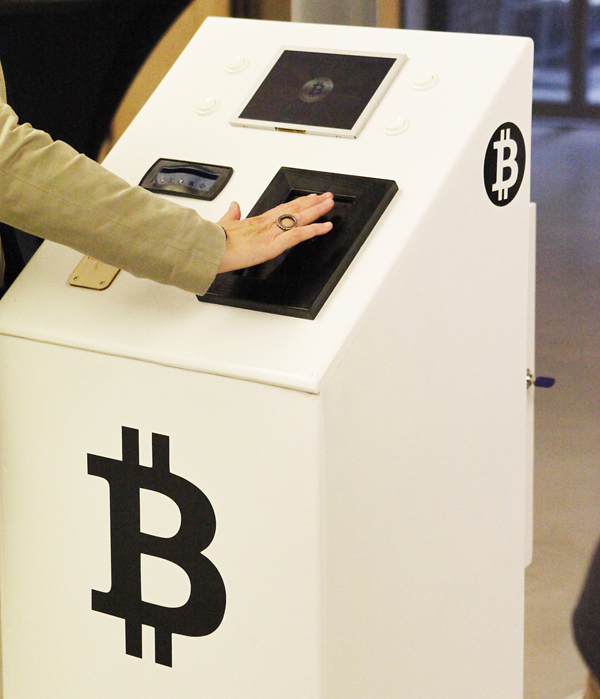
“Money is a social construct that largely exists in people’s minds” Brett Scott
Money Watching (2007) was a performance by Cesare Peitrousi as part of the series ‘Paradoxical Economies’ by Ikon Gallery. A shop in a commercial area of Birmingham was used to sell £10 and £20 notes. Purchase took the form of an investment of time and attention; in order to receive a note the customer had to actively contemplate it for a given amount of time – 15 minutes (7:30 each side) for the £10 and 25 minutes (12:30 each side) for the £20. Today we might think this performance gestures towards the command money represents over a labour power that so often takes the form of creativity and attention. For Max Haiven, a presenter at Moneylab, the performance illustrates the social construction of money. It reveals for a moment the ongoing creative investment and sociality of trust necessary for the collective production of categories such as currency and value.
But what might it mean for us to understand that money is socially produced? After all the fictitious nature of financial capital is already publicly acknowledged. The crises in the global economy drew our attention to the speculative activities of financial markets, the rapid fluctuation of fiat currencies with little or no relationship to intrinsic value and the creation of fictitious profits through the proliferation of exotic financial instruments. We wondered at the creation of money ‘out of thin air’ and wondered just as much at its easy dissolution. But these conditions also brought with them a ‘fracturing of the imagination of power’ – an understanding that if the crisis opened our eyes to the plural nature of financial capital it also opens money to interpretative flexibility. Finance reveals itself as a social invention; as Tiziana Terranova put it, money is designed and as such it can be designed differently. Our attention is now drawn to the ways in which people all around the world are producing new media for exchange, new types of payment and even new measures of value.
Moneylab: Coining Alternatives was a two-day conference in March 2014 that brought academics, activists, artists and economists together to discuss alternative revenue models. The event was an initiative of the Institute of Network Cultures and took place in Lab 111, Amsterdam. Conference panels provided an introduction to financialization and the key concerns surrounding global finance; however, the main focus was not on providing a primer or academic investigation into the workings of finance or the technical specifics of cryptocurrency (although there was lots of useful information to be had) but on advancing and critiquing alternative currencies, systems of exchange and funding models outside of state or market intervention. The typical conference format was also augmented by ongoing crowdfunding workshops, performances and demonstrations, and an ‘Alternatives Bazaar’ featuring showcases from various monetary schemes based in the Netherlands.
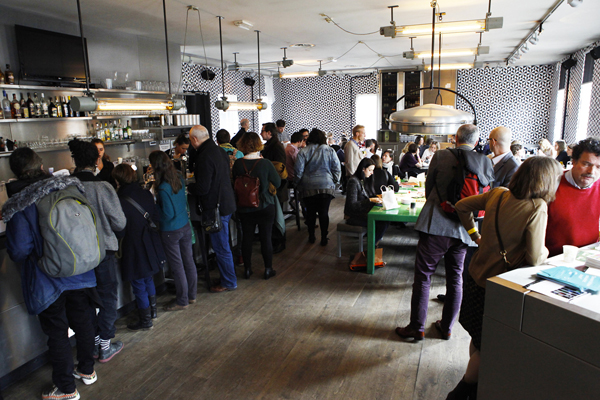 [Moneylab Image]
[Moneylab Image]
Alt Currency: Why seek alternatives now? On the one hand financial crises and the failures of both the state and the market suggest the need for a third way of managing and producing money. On the other hand the proliferation of technological instruments for negotiation and exchange suggest that nonmonetary alternatives might now be possible at an organisational level that challenges state institutions and/or the market. Today we’re seeing the return of pre-capitalist and nonmonetary forms of currency in the digital realm.
For example, where previous gift or barter economies were limited in scale, a number of presenters and practitioners at Moneylab identified technological solutions to these limitations. Stefan and Ralph Heidenreich in ‘Dismantling Global Finance’ and Lana Swartz presenting in ‘Designing Alternatives’ pointed to new technologically-mediated responses such as peer-to-peer networks and data-rich network algorithms as solutions to the classic matching and distribution problems of who gets what resource and for what action. A fledgling example of this in action was #PunkMoney, presented by Eli Gothill, an alternative currency that uses social media networks and their associated reputation economies. Users can ‘print money’ as tweets. These take the form of promises or IOUs such as “I will rake your leaves” that can be redeemed or transferred by the receiver. All tweets are tracked on the #PunkMoney site, creating a record of the promise, while the users online reputation acts as a mechanism of trust and guarantee. Other approaches were highlighted by initiatives on display in the Alternatives Bazaar downstairs, with projects such as Timebank.cc, a skill and service exchange that distils exchangeable units to one hour of human labour. A similar approach is taken by Noppes.nl, a long-standing alternative currency based in Amsterdam and used to exchange goods and services.
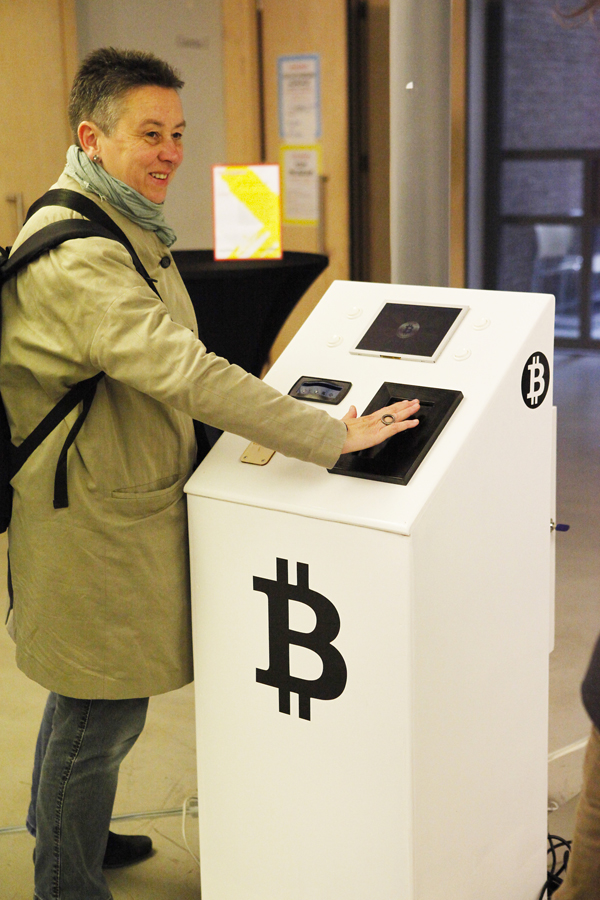 [Bitcoin Atm Image]
[Bitcoin Atm Image]
A significant part of Moneylab was also devoted to the constraints and affordances of crowdfunding and pay-if-you-want schemes, with panels and workshops dedicated to developing successful crowdfunding initiatives and imagining alternative funding infrastructures. In turn, there was a particular focus on how these new funding structures affected cultural entrepreneurs and the shape of the cultural industries in Amsterdam and beyond.
Unsurprisingly, cryptocurrencies featured heavily in the search for alternatives, as did new forms of electronic payment, digital-financing forms and mobile money. Hacker communities and critics of financialization have presented Bitcoin as a decentralised currency operating outside of the control of state-governed institutions or neoliberal markets. Here the development of p2p payment is presented as an appropriation of the means of money creation and management. ‘Bitcoin and Beyond’ analysed some of these claims made for Bitcoin and other cryptocurrencies. Eduard de Jong provided a rich historical trajectory of electrons as cash from the use of phone cards in the mid 1970s to initiatives such as DigiCash and T-Money right through to present-day cryptocurrencies. Quinn DuPont spoke of the history and politics of cryptography, while speakers Peter Surda and Beat Weber occupied opposing positions on the future of Bitcoin as an anticapitalist currency or monetary commons. In the Friday afternoon panel on ‘Mobile Money’, Erin Taylor traced the development of mobile payment systems from informal exchanges of phone credit through to a social good supported by telecommunications companies and NGOs. Part of a general ICT for development (ICT4D) approach, services such as M-Pesa are now seen as a means of extending financial services to the ‘underbanked’ communities of the Global South. Here the medium is the money, so to speak, where handsets and airtime function as both currency and commodity at one and the same time.
Artists and activists at Moneylab also imagined other theoretical, creative and practical attitudes to currency. Brett Scott, founder of the London School of Financial Activism (LS£A) and author of The Heretics Guide to Global Finance: Hacking the Future of Money (2013, Pluto press) translates the hactivist approach to the financial sector. Here ‘hacking’ first means developing situated knowledge about alienating financial systems and secondly developing potentially disruptive and transformative techniques to reshape finance from below. Tactics outlined by Scott include ‘shareholder activism’: basically using shareholding to disrupt traditional modes of operation in a company. In a similar display of “economic circuitbending” (Scott, 2013), theorist Max Haiven asked us to think about money as an artistic medium in the panel Designing Alternatives. Understanding currency in terms of aesthetics might potentially lead to new ways of imagining not only money but also the way it is configured in relations between people, Haiven argued. This creative power of currency was well illustrated by groups such as the Kunst Reserve Bank and Geheimegentur & the Theatre of Research who have developed their own currencies and even systems of value through art and theatrical performances.
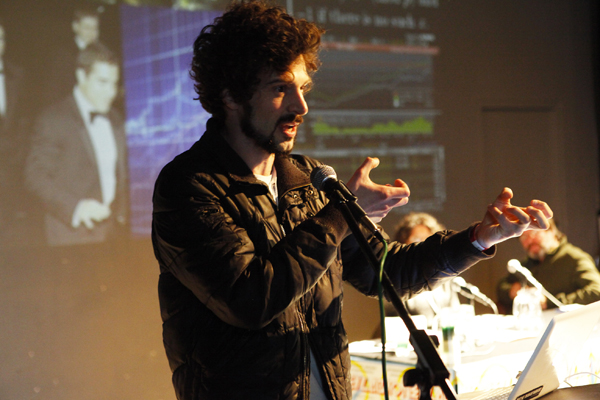
[Brett Scott: Applying the Hacker Ethic to the Financial System]
Alternatives to What? At the same time, there was a recognition that these alternatives also required attendant forms of critique. As Brian Holmes was quick to point out, such an approach is necessary if we aren’t to slip into a rhetoric that simply reproduces sentiments of collectivism as a temporary solution to an impasse of neoliberal economics. This critical perspective on the alternatives presented was provided by the presenters themselves or in ensuing discussions with the wider audience. In fact, there were more insightful approaches than I can do justice to here, but I’ll look to a few.
Sometimes in the quest for digital alternatives it’s possible to overlook the material consolidation of power. As Bill Maurer asked “who controls the distribution of authority and credibility in these systems?” and in the service of whom? Speaking on ‘Closed loops and Private Gateways: Money, Technology and the Public Interest in Payment’ Maurer made an invaluable distinction between the question of money as a token or information and money as infrastructure in the form of financial institutions and transfer networks. While the former is socially produced, the latter is consolidated in material, infrastructural and juridical limitations that continue to constrain our ability to enact new forms of credit. Power is consolidated not only in a socially constructed token, therefore, but also in the infrastructures that support financial transactivity. Where historically this refers to the introduction of institutions such as the Federal Reserve and the Central Bank to guarantee currency, today we encounter conditions where our telecommunications and network service providers are emerging as veritable financial institutions. For example, Mobile Network Operators and service providers now play a significant role in mobile and online payment and emergent services such as PayPal are inserting themselves into publicly mandated systems in ways that are inherently political. It became clear, therefore, that for alternatives to be materially realised and reproduced, the political economy of our credit infrastructure also needed to be addressed. In the current system we can produce as much ‘virtual money’ as we want so long as we remain unconcerned with where the consolidation of power in the physical infrastructure that supports transactions. This calls for a much more critical perspective on the future of digital currency and mobile money. As Max Haiven warned, at times like these we risk getting caught up in the romance of the moment and failing to see where power really operates.
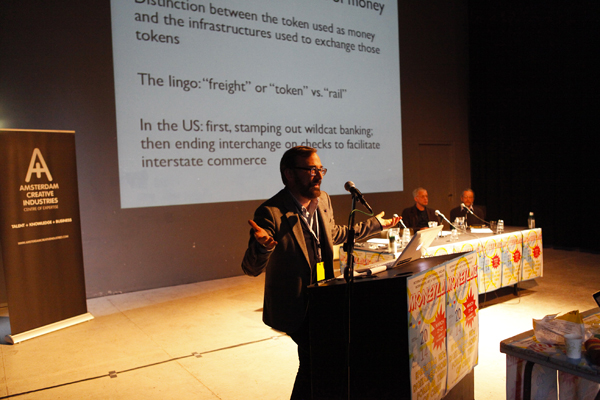
[Bill Maurer: Closed Loops and Private Gateways]
It also became clear that we needed to think more not only about the ownership and consolidation of financial networks new and old, but also about what kinds of work the financial technology does. Claims that network media have solved the relational problems of transactivity, producing technologically-mediated forms of trust and cooperation between strangers, are tempered by a recognition that the control society has its own algorithmic logic. As Bifo maintained in his presentation ‘Money Language Insolvency’, the problem becomes one of embedding the command of the law through tools that are embedded in forms of linguistic and monetary exchange, transforming a normative law into a cryptographic or software-defined law. Quinn Dupont made a similar observation when he likened the logic of cryptocurrency to the modulating and free-floating forms of command described in Deleuze’s ‘Postscript on the Societies of Control’. Once more, if computers are now in charge, who is in charge of the computers? In other words, what kinds of command, but also sociality and exchange are being written into our software?
This brings us to a second consideration of the agency of these technical systems. There were many proposals – particularly in relation to peer-to-peer payment systems – to construct monetary forms where social institutions and local trust are entirely delegated to technical processes. And this too is worrying for different reasons. It seems to suggest not so much a ‘monetary commons’, where technology stands in for negotiation and trust and all the messiness of human transactions, but a new kind of technologically-mediated capitalism without the necessary supporting social institutions. But what happens to the commons when sociality is abdicated in favour of a cryptographic protocol? As Ralph and Stefan Heidenreich pointed out, money is a fundamental social institution and can’t be provided by a market or automated systems alone without serious problems. This sentiment was echoed in criticisms of peer-to-peer payment systems. As well as detailing some of the difficulties identified by critics of Bitcoin – its deflationary tendencies, instability and regulatory issues – Beat Weber from the Austrian Central Bank argued that peer-to-peer payment systems, far from representing a monetary commons, were instead an ideal financial asset for rent-seeking forms of capitalism.
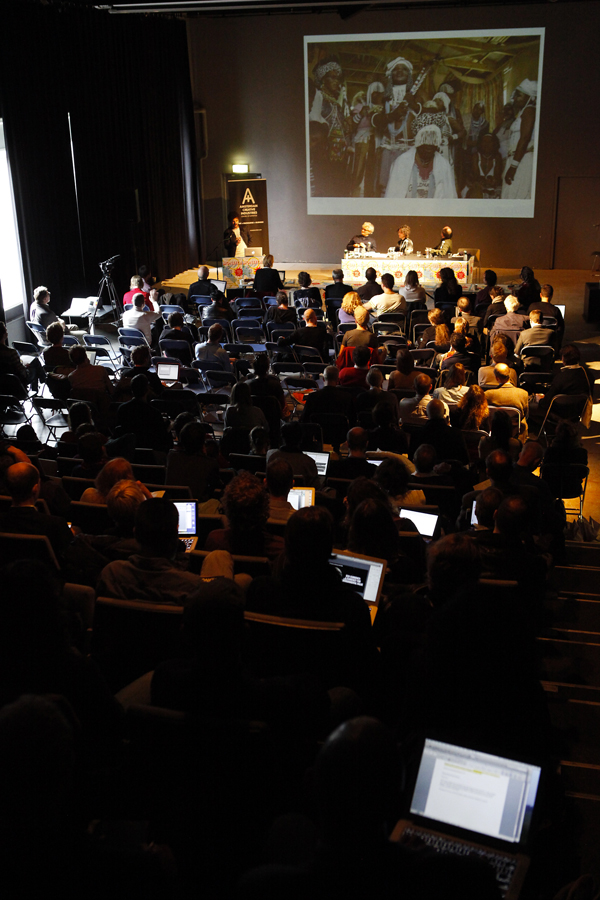
[Panel: Dismantling Global Finance]
Finally it was very clear that various techno-utopian claims for networked payment systems as fundamentally anti-capitalist needed to be critically assessed. And certainly there was an ambivalence to some of the coined alternatives in Moneylab. In some cases it seemed that the projects presented were little more than capitalist fixes cloaked in the rhetoric of dot-communism. There were proposals to enclose and monetise nonmarket forms of sharing and sociality; Share NL, a platform for the Dutch sharing economy and described as ‘one of the ten ideas that will change the world’ seemed to be about drawing every aspect of social production inside the realm of market transactivity. So too a panel purporting to be a ‘Critique of Crowdfunding’ was for the most part a very uncritical fantasia on the model as a social and collectivist project for future welfare. This claim coexisted with an oblique demand for relationality and subjectivity as entrepreneurship, embraced in the ongoing workshops encouraging participants to ‘Crowdfund their dreams’. While it can be very difficult (and not always useful) to try and draw distinctions between the righteous skill-shares and the corporate Airbnbs of this world, there still wasn’t enough criticality of how collectivist projects across online platforms, collective funding or peer-to-peer payment coalesce with a liberal economy based on principles of individualism and the free market.
Moneylab was a truly excellent forum to tease out many of these issues. How can we understand the world of finance well enough to engage and disrupt it? How can we think critically about the design and control of technical systems? For every chokepoint there’s also a recognition of the ways in which money is first and foremost a communicative act. Tiziana Terranova, speaking on ‘Virtual Money and the Currency of the Commons’ asked how we could pose the problem of currency design in a way that made it possible for individuals and different communities with varying needs and competencies to engage. As Terranova concluded, there is no need for a single right answer, but a proliferation of alternatives, a monetisation from below to counter the revolution from above.
 [Tiziana Terranova_Virtual Money & the Currency of the Commons]
[Tiziana Terranova_Virtual Money & the Currency of the Commons]
Rachel O’Dwyer
[Images courtesy of Institute Of Network Cultures]
















 [Tiziana Terranova_Virtual Money & the Currency of the Commons]
[Tiziana Terranova_Virtual Money & the Currency of the Commons]